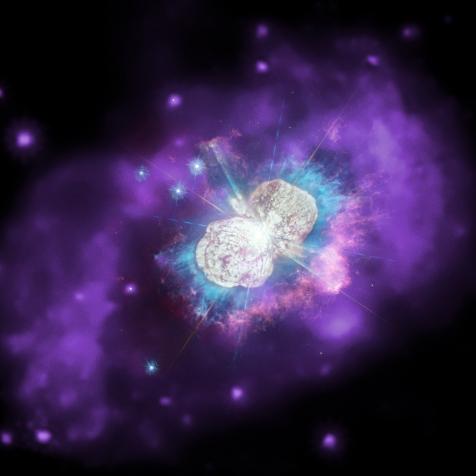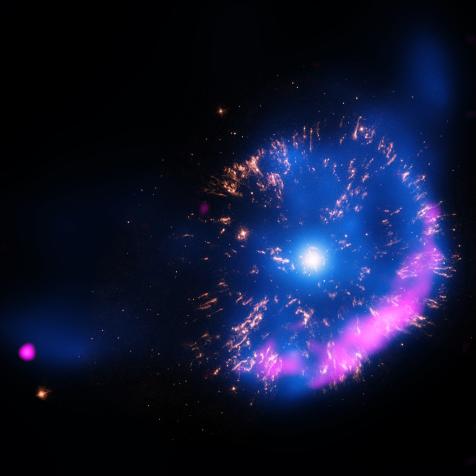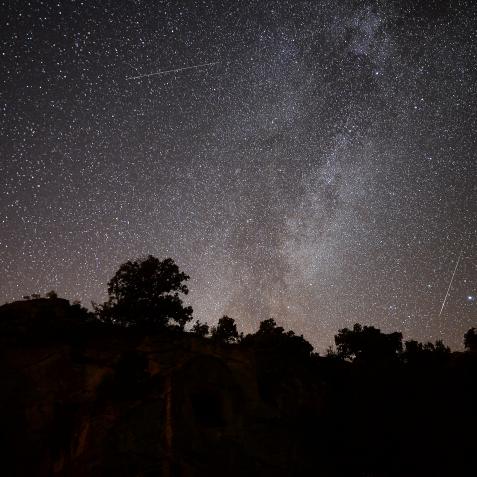
NASA/CXC/Curtin University/R. Soria et al.
A Galaxy’s Love-Hate Relationship with Black Holes

You all have that person in your life. One minute they have you in stitches. The next they’re driving you nuts. You want to let go of this person but you just can’t…and the next day, you wish you never had the thought.
You’re not alone, and what happens at the human level also happens at the cosmic level.
At the center of the Milky Way galaxy sits a giant black hole. And I mean giant – it’s at least four million times the mass of our sun. And while that still makes it less than 1% of the entire mass of the galaxy, it’s still the single largest object around. And it has a temper.
Occasionally material, or a wandering star, gets too close to that giant monster. And the gravitational pull near a huge black hole is…well, extreme. Extreme enough to rip that material or star to shreds. That process releases a lot of energy, usually in the form of a huge blast of radiation.
We can see evidence of this process in the wreckage surrounding our galaxy’s black hole. They’re called the Fermi Bubbles, and they are two vast regions of super-heated plasma extending thousands of light-years above and below the plane of the Milky Way. It’s the leftover belch from a meal consumed millions of years ago.

NASA, ESA, and Gerald Cecil (UNC-Chapel Hill)
The graphic of a translucent, vertical white fan is added to show the suggested axis of a mini-jet from the supermassive black hole at the galaxy’s heart. Farther down near the black hole are X-ray observations of superheated gas colored green and blue. These dates are circumstantial evidence that the black hole occasionally accretes stars or gas clouds, and ejects some of the superheated material along its spin axis.
Normally, you would think all this high-energy activity would be a bad thing. In many cases, you’d be right. If the Earth were situated much closer to the galactic center, we’d be cooked to a crisp from all the radiation. Thankfully, the giant black hole is safely tucked 25,000 light-years away.
All these bursts also disrupt star formation, which is an activity that galaxies really enjoy doing. To make stars, you need to take massive clumps of matter and collapse them down into tiny volumes. But in order to do that, you need to make the gas cold, otherwise, it will simply refuse to budge. This process happens normally all throughout the galaxy, but in the center, it can go haywire. When the black hole is angry, it dumps too much energy into its surroundings, preventing the formation of new stars.

NASA/CXC/Wisconsin/D.Pooley & CfA/A.Zezas
At the center of spiral galaxy M81 is a supermassive black hole about 70 million times more massive than our sun.
But…that’s not necessarily a bad thing. Left to their own devices, galaxies may tend to make stars a little too quickly. There’s only so much matter in any single galaxy, which limits how many total stars it can create in its lifetime. If it makes stars too fast, it will run out of material, and eventually, fade from the cosmic scene.
That nasty and temperamental black hole, however, can regulate star formation, keeping it to a slow and steady pace instead of a one-and-done affair. This allows galaxies like the Milky Way to keep forming stars for billions, even trillions, of years.

NASA/CXC/MIT/UCSB/P.Ogle et al.
A composite Chandra X-ray (blue/green) and Hubble optical (red) image of NGC 1068 shows hot gas blowing away from a central supermassive black hole at speeds averaging about 1 million miles per hour. The elongated shape of the gas cloud is thought to be due to the funneling effect of a torus, or doughnut-shaped cloud, of cool gas and dust that surrounds the black hole.
So I would say that the relationship status between galaxies and black holes is…complicated.
Dive Deeper into the Cosmos
Journey Through the Cosmos in an All-New Season of How the Universe Works
The new season premieres on Science Channel and streams on discovery+.




















